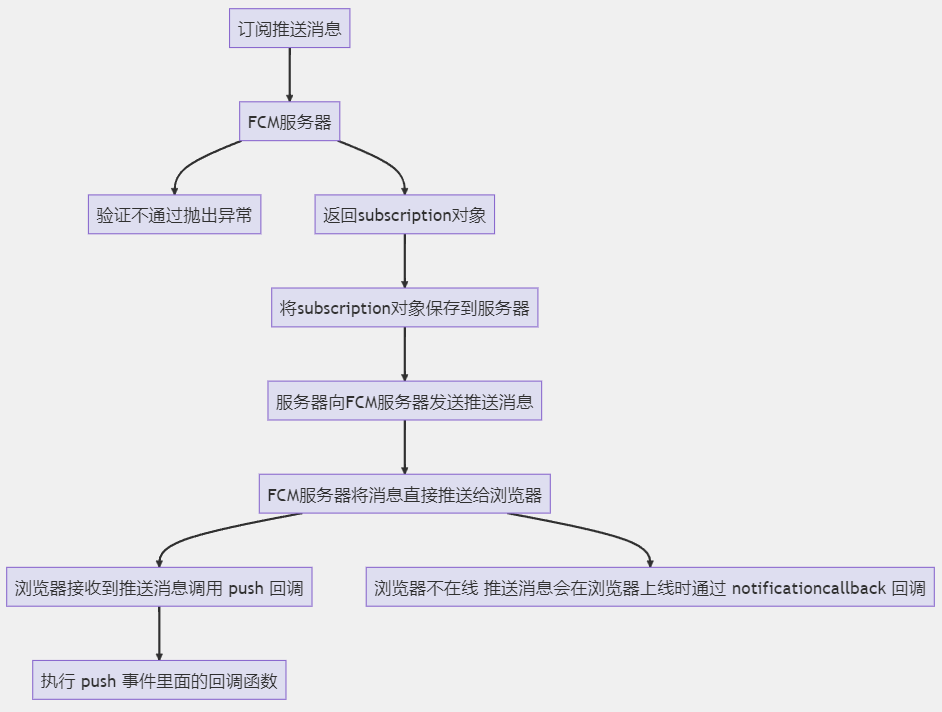Background Fetch API
Background Fetch API 提供了一种管理可能需要大量时间的下载的方法,例如电影、音频文件和软件等。
其提供了一种让浏览器在后台执行某些获取的方法。然后,浏览器以用户可见的方式执行提取,向用户显示进度并为他们提供取消下载的方法。下载完成后,浏览器就会在 ServiceWorker 触发相关事件,此时应用程序可以根据需要对响应执行某些操作。
如果用户在离线状态下启动进程,后台获取 API 将启用。一旦网络连接,该过程就会开始。如果网络离线,该过程将暂停,直到用户再次上线。
该 API 通过 BackgroundFetchManager 接口提供,并基于 ServiceWorkerRegistration 接口的 backgroundFetch 属性向开发者暴露。
发起 Background Fetch
BackgroundFetchManager 接口的 fetch() 方法用于注册一条后台获取。
方法接收一个字符串参数作为该后台获取的 ID;
然后接收一个 Request 或者一组 Request,可以是代表 URL 的字符串(会被传递给 Request 构造函数)或者 Request 实例;
最后接收一组可选的配置项,用于配置浏览器向用户展示的获取进度条对话框:
配置项的 title 参数指定对话框的标题;
配置项的 icons 参数指定对话框的一组图标,浏览器会从中选择一个图标用于对话框的展示:每个图标的 src 参数指定图标路径、sizes 参数指定图标的大小(格式同 link 标签的 sizes 属性的格式相同)、type 参数指定图标的 MIME 类型、label 参数指定图标的名称;
配置项的 downloadTotal 参数指定预计的获取资源总大小(字节),若实际获取资源总大小超出该数值,获取会终止;
方法返回一个 Promise 的 BackgroundFetchRegistration 实例。
1 | const ID = 'fetch' |
Background Fetch 信息
可以使用 BackgroundFetchManager 接口的 get() 方法根据给定的 ID 获取对应的 Background Fetch。 若存在,方法返回一个 Promise 的 BackgroundFetchRegistration 接口实例,否则返回一个 Promise 的 undefined。
此外,可以使用 BackgroundFetchManager 接口的 getIds() 方法获取当前所有 Background Fetch 的 ID 列表,返回一个 Promise 的字符串数组。
BackgroundFetchRegistration 接口用于表示后台获取的实时信息,以及一些控制方法。
BackgroundFetchRegistration 接口的 id 属性表示后台获取的 ID。
BackgroundFetchRegistration 接口的 downloaded 属性表示后台获取已下载资源的大小,初始值为 0。
BackgroundFetchRegistration 接口的 downloadTotal 属性表示后台获取将下载资源的总大小,该值在初始化时设置,若未设置则为 0。
BackgroundFetchRegistration 接口的 uploaded 属性表示后台获取已成功发送内容的大小,初始值为 0。
BackgroundFetchRegistration 接口的 uploadTotal 属性表示后台获取将发送内容的总大小。
BackgroundFetchRegistration 接口的 recordsAvailable 属性表示当前是否有可以获取的请求及响应,该值同样用于表示是否可以调用 match() 和 matchAll()。
BackgroundFetchRegistration 接口的 result 属性表示后台获取是否成功,可能的值为 '' success failure。
BackgroundFetchRegistration 接口的 failureReason 属性表示后台获取错误的原因,可能的值为 '' 'aborted' 'bad-status' 'fetch-error' 'quota-exceeded' 'download-total-exceeded'。
BackgroundFetchRegistration 接口的 match() 方法用于匹配当前后台获取中的后台请求。返回一个 Promise 的 BackgroundFetchRecord 接口实例或 undefined,表示首个匹配。
BackgroundFetchRegistration 接口的 matchAll() 方法用于匹配当前后台获取中的后台请求。返回一个 Promise 的 BackgroundFetchRecord 接口实例数组,表示所有的匹配。
两方法支持传入一个请求实例 Request 或 URL 或路径字符串,同时支持传入一个可选的配置项,ignoreSearch 参数指定是否忽略搜索参数,ignoreMethod 参数指定是否忽略请求方法,ignoreVary 参数指定是否忽略 Vary 响应头。
BackgroundFetchRecord 接口用于表示单个后台请求及响应信息。
BackgroundFetchRecord 接口的 request 属性表示请求信息,返回一个 Request。
BackgroundFetchRecord 接口的 responseReady 属性表示响应信息,返回一个 Promise 的 Response。
BackgroundFetchRegistration 接口的 progress 事件在当前后台获取的信息更新时触发,包括 downloaded 属性、uploaded 属性、 result 属性、failureReason 属性,事件只抛出一个普通的 Event 事件。
注销 Background Fetch
BackgroundFetchRegistration 接口的 abort() 方法用于终止当前后台获取。返回一个 Promise 的 boolean,表示是否终止成功。
1 | const ID = 'fetch' |
Background Fetch 结束处理
ServiceWorkerGlobalScope 接口的 backgroundfetchclick 事件在用户点击浏览器提供的下载进度条弹出框时触发。返回一个 BackgroundFetchEvent 事件。
ServiceWorkerGlobalScope 接口的 backgroundfetchabort 事件在后台获取被取消时触发。返回一个 BackgroundFetchEvent 事件。
ServiceWorkerGlobalScope 接口的 backgroundfetchfail 事件在后台获取失败时触发,即至少有一个后台获取内的网络请求失败。返回一个 BackgroundFetchUpdateUIEvent 事件。
ServiceWorkerGlobalScope 接口的 backgroundfetchsuccess 事件在后台获取完成时触发,此时所有后台获取内的网络请求已经完成。返回一个 BackgroundFetchUpdateUIEvent 事件。
1 | self.addEventListener('backgroundfetchsuccess', (e) => { |
BackgroundFetchEvent 接口继承自 ExtendableEvent 接口,其 registration 属性代表与之对应的 BackgroundFetchRegistration 实例。
BackgroundFetchUpdateUIEvent 接口继承自 BackgroundFetchEvent 接口,其 updateUI() 方法用于更新浏览器提供的下载进度条弹出框的信息。接收一组参数,包括 icons 及 title 参数,与 BackgroundFetchManager 接口的 fetch() 方法中的相应参数相同。返回一个 Promise。
权限 API
该 API 调用需要用户授予 background-fetch 权限,可以调用 Permission.query() 方法检查用户是否已授予了该权限
示例
- https://github.com/skyclouds2001/Frontend-Learning/blob/main/next-learning/background-fetch.html
- https://github.com/skyclouds2001/Frontend-Learning/blob/main/next-learning/background-fetch.js
类型
1 | type BackgroundFetchFailureReason = "" | "aborted" | "bad-status" | "fetch-error" | "quota-exceeded" | "download-total-exceeded"; |
